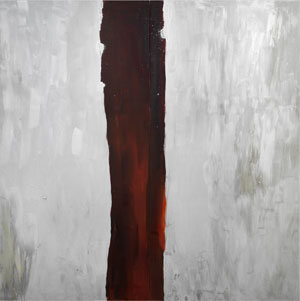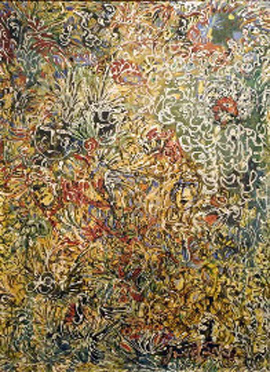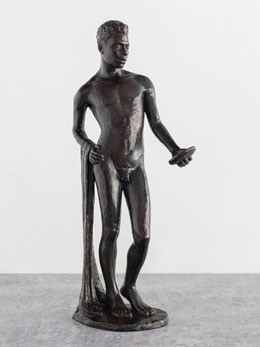Skipping the Fairs
John Haberin New York City
The 2024 New York Art Fairs
After so many years and so many vows, I finally got up the courage: I skipped the spring New York art fairs. Well, not quite, but I did skip the massive, classy May leaders, Frieze and TEFAF. I felt the relief from the pressure to see it all, to record it all, and to pick winners. That is not what I think good criticism can and should do. Can I bring myself to skip the Armory Show and the mad rush in September?
We shall see, but for now I stuck to the alternative fairs. As usual, a small fair for African and African America artists, I-54 (now in the Starrett-Lehigh building west of Chelsea galleries), provides a touch of diversity and invention.  As usual, too, the Independent in Tribeca brings a much-needed quality and energy. It also comes a week later than the rest, as if to say that you missed nothing. That leaves what might, generously, be called the strivers. Are these really the alternatives in art now? Maybe not, but a new fair, Esther, heads across town to a nineteenth-century townhouse that welcomes and clashes happily with the art.
As usual, too, the Independent in Tribeca brings a much-needed quality and energy. It also comes a week later than the rest, as if to say that you missed nothing. That leaves what might, generously, be called the strivers. Are these really the alternatives in art now? Maybe not, but a new fair, Esther, heads across town to a nineteenth-century townhouse that welcomes and clashes happily with the art.
Call your mother
As ever, Salon Zürcher claims the title of a fair for a group show of eleven women. It includes rubbings by Margaret Cogswell that seem to dive into the wreck, a tight grid of holographic tape by Marietta Hoferer, collage abstraction with an emphasis on color by Phillis Ideal, and faces barely hiding their identity and anxiety by Judith Henry. They show the advantages of a curator's choices, and a self-curated fair like Clio or Superfine can only drive that home. Not everyone without a gallery is too adventurous for the system, and tightly hung clusters of work barely rescues it from the trash. Still, the strivers within the system do drive the action, not least the members of the New Art Dealers Alliance. Whether as NADA House on Governors Island or again in the former Dia:Chelsea, where the Independent, too, got its start, it is a place for young old favorites.
NADA's fair has expanded to a truly international gathering, including nonmembers, most with stripped-down versions of their current shows. Still, it may work better as a supporting network than a fair. So does the Future fair, despite some inviting selections of abstract art with Kathryn Markel by the entrance. Booths had me wishing after all for the game changers and market leaders at Frieze in the Shed. Still, as Maynard Morrow (with GAVLAK) has it in a text painting, The Future Tis Not Ours to Ruin. Morrow, though, appears in another fair entirely with a real future, the Independent.
For its fifteenth anniversary, its alternative fair takes three rooms for fifteen galleries and artists from past years. They make a delightful noise—in wild and wooly takes on figurative art in 3D. Better, though, are the uncrowded booths for enduring but still adventurous galleries, media, and genres. Abstraction appears as a dialogue, as Alan Uglow and Jane Swavely (with Magenta Plains) trade horizontals and verticals as bases for its space—and as Kate Spencer Stewart (with Bureau) shows just how far brushwork and color can go within near-monochrome darkness. Andrew Brischler (also with GAVLAK) constructs portraits in close-up, but with a moving psychological reserve. Their hand-painted dots belong to neither Pop Art and commerce nor the digital and AI, but rather to a vivid sense of the present.
And then there is Esther, like the sound of your mother calling and unseen voices answering back. Margot Samel, a small dealer with an Estonian heritage, met up with an Estonia dealer, Olga Temnikova, and invited friends. They set out a welcome mat reading Esther at the entrance to Estonian House, normally a private club. Samel herself places a ceramic flower pot as if it had always been there, among works by Kris Lemsala, Bertha Leonard, and August Krogan-Roley. Facing it, a blue robe from Lewis Miller and Jesse Wine (with the Modern Institute in Glasgow) hovers beneath the wood molding like a ghost. If you feel out of place climbing the stairs, you may sense the ghosts.
Claims aside, Esther has only modest emphasis on Eastern Europe. You may not even know for sure just what is from where, as the display relies on a map rather than labels—so forgive me if I fell prey myself to mistaken identity. Diagonal partitions confuse things that much further, although they enliven wildly cut panels by Ernesto Burgos with Simone Subal. Yet the surroundings do matter. Another Tribeca gallery, Andrew Kreps, sets out a painting of eyes, in work from Camille Blatrix and Hadi Falapishi, as if watching you and the artists alike. They look skeptical, but they are just part of the show.
A visit could be a tour for prospective club members or a game of Clue. It even has a pool room, where Talia Chetrit and Skuja Bradner (with Kaufmann Repetto) set their ceramics on the pool table. Nearby, Tom Forkin (with Someday) removes the pool table from a noted painting by Vincent van Gogh, dragging his brush across versions in monochrome and color. On the piano of all places rests a monitor, like the ultimate collision of old and new media. On video, Bony Ramirez and Oliver Herring (with BANK in Shanghai) invite artists in China to take their moves to a construction site seemingly in ruins, where they seem less to dance than to roll in mud and white dust. From art fairs to entire nations, the future will not come easily or all at once.
Under pressure
For years I had promised myself to skip the New York art fairs. What can they add to an already busy gallery scene in New York? What can they bring to the special pressure of that first week after labor day, when openings run wild? If those same galleries find their sales dropping, and more and more experience dealers are calling it quits, the fairs bear their share of the blame here, too. So if I could cut back at last this past spring, could I pull it off again in September? Could a compulsive critic withstand the compulsion?
Maybe not, but I could look once again for the alternatives. That has its drawbacks, too. Who feels the costs more than the kind of galleries that exhibit at "alternative fairs"? If they are not on a budget, who is? Others may feel under pressure to splurge on booths at two fairs, the Armory Show and one more, closer to their buyers and their roots. Still other exhibitors have no dealers or curators, only aspiring artists, and what ever too often is the pleasure for a critic in that?
I have no answer, but I still have my compulsions. And what could be more of an outsider than a fair with just one dealer, the gallery that hosts it, but calls itself an Armory Show affiliate anyway—Salon Zürcher for "11 Women of Spirit +"  If "Spirit +" sounds more like a flavored vodka than a true shot in the arm, it allows Zürcher to reset its count of editions to Part One. It still leans to women in abstraction, a timely enough cause as well. It may be running thin, especially after a summer group show of a hundred women, but such is the pressure to exhibit art.
If "Spirit +" sounds more like a flavored vodka than a true shot in the arm, it allows Zürcher to reset its count of editions to Part One. It still leans to women in abstraction, a timely enough cause as well. It may be running thin, especially after a summer group show of a hundred women, but such is the pressure to exhibit art.
It does have charming enough local landscapes by Brigid Kennedy—and charming enough knitted portraits by Mary Tooley Parker. Marykate O'Neil groups her portraits of leisure, with a woman, perhaps the artist, sipping wine on a larger scale if passing judgment on them all. Abstraction, in turn, can be jazzy, as with Susan Cantrick, or brushier, as with Patricia Spergel, who adds an artist painting. Still, it does tend to run together. I remember more the work that lives between abstraction and figuration—flowers by Tracy Morgan and open skies by Sue Carlson with a yellow arc on top. I took it all in but was ready to move on.
Once Volta was a path-breaker, the fair with single-artist booths, the fair that makes you look and remember. Now even a room for Ukrainian artists packs them in, everything looks familiar, and wiser galleries exhibit elsewhere. A girl at night on a country road, in black-and-white photos by Sophie Zhai (with London's Mandy Zhang) or portraits of blackness, in color photos by Joanne McFarland (with Accola Griefen)? Yeah, sure, although both stand out, and McFarland's sitters could be role models, plastic dolls, or the baby girl next store. Maybe, though, the real problem lies with the fairs, all of them? Can anything stand out any longer in all the madness?
You may not think so at Clio, borrowing the space of a Soho gallery, where artists choose themselves with predictable results. Look instead to what could be the true New York scene, its office buildings, and Spring/Break seems out to explore them all. The fair that sounds like a holiday at the beach has moved to Hudson Square north of Tribeca, and it fits right in. Small offices offers close-ups, but office culture shines best in common areas. The fair does have painting, from cheery abstraction to dark fantasies, and sculpture, like an eccentric chess set or large wood pieces in a forgotten game (and I do not name artists because Spring/Break often fails to identify them). Still, it seems only right that one office holds Post-It notes, and one artist leaves out his colored geometry as if taking over the bar.
Two piers for art
Art on Paper should be just the thing for buyers who cannot afford the Armory Show. So what if the work also looks cheap? Like Rembrandt, artists have always put their thoughts on paper for some of their most lasting and original work. Yet the stress here is on reproductions or close to it, and no one seems to have encountered, much less read, an artist's book. The fair has its share of commerce as well, like a display of luxury cars at back and stands touting "the art of wine." Neither is made of paper.
Nor are paintings by Elise Ferguson, in patterned curves that rather familiar themselves. Painting turns up as well in performance, by Fabien Dettori. Ching Ka Lin and Ching Ke Lin make sculpture from bamboo strips—a home on wheels and an orange helix. All four are among the fair's special projects, once again a highlight. (Keep your eye out, because all but one fit neatly into booths rather than the aisles.) The pier off the Lower East Side could be worth the trip for its high ceilings and uncrowded display alone. Now what about works on paper? 
Why, then, attend the fairs at all? The Independent comes to New York twice a year these days—once to a Cipriani restaurant and with not a trace of the passing scene. Is that classy or what? Fortunately, it also pays off with only twenty-eight exhibitors but nonstop rediscoveries of modern art. Sure, two booths fall back on Pablo Picasso and Gerhard Richter, the first with prints and the second with lesser-known series, but such is the price they pay for the expected. The fair does best, though, when it stretches the very meaning of Modernism and art's history.
A young Stuart Davis (with Alexandre) does, immersed in the city's dance halls, delis, protests, and burlesque, with all their uncanny darkness and light. He anticipates everything from Edward Hopper on his long walks to political art today. Janet Sobel does, too, as the very first drip painter, and critics, starting with Clement Greenberg himself, have rediscovered her so often that you might think there is nothing left to know. Hey, John Dewey, the philosopher, wrote her. Here, though, James Barron pairs her persistent realism with Sol LeWitt at his densest and loosest, and it works. I shall just have to take on faith that Hallwalls Contemporary Arts Center in Buffalo stretched the art scene as well, should anyone have seen it.
Naturally there are women, like Squeak Carnwath (with Jane Lombard) who makes cryptic but clearly feminist notations into large canvas or an entire wall. There are people of color like Simões de Assis (with Galatea) in Rio, who makes every family gathering a carnival. There are black women, too, like Lenore Tawney (with Alison Jacques), whose assemblage has its broken eggshells and other mysteries and whose cast unexpected color in their shadows. Ryan Lee pairs painting by Emma Amos with sculpture by Richmond Barthé, whom Isaac Julien has placed at the center of his video history of the Harlem Renaissance. His black nudes seem more artful and less quaint faced with her male mingling with an octopus. One need not know that Amos has traced her own history in art to Africa.
Will I regret skipping the Armory Show at the Javits Center? Of course, I would have enjoyed it and the outsize convention hall—more than any alternative. I brings out the best in countless exhibitors, old and new, by obliging them to think big, and it must itself have been thinking big itself on its thirtieth birthday. Still, hope that next year I really will do my job, by cutting back still further on the fairs. Now if only what has become a nonstop, year-round global event could cut back, too. Oh, and don't trust anything over thirty.

The 2024 spring New York art fairs ran from May 2 to May 5, but with the Independent one week later, and from September 5 to 8.




